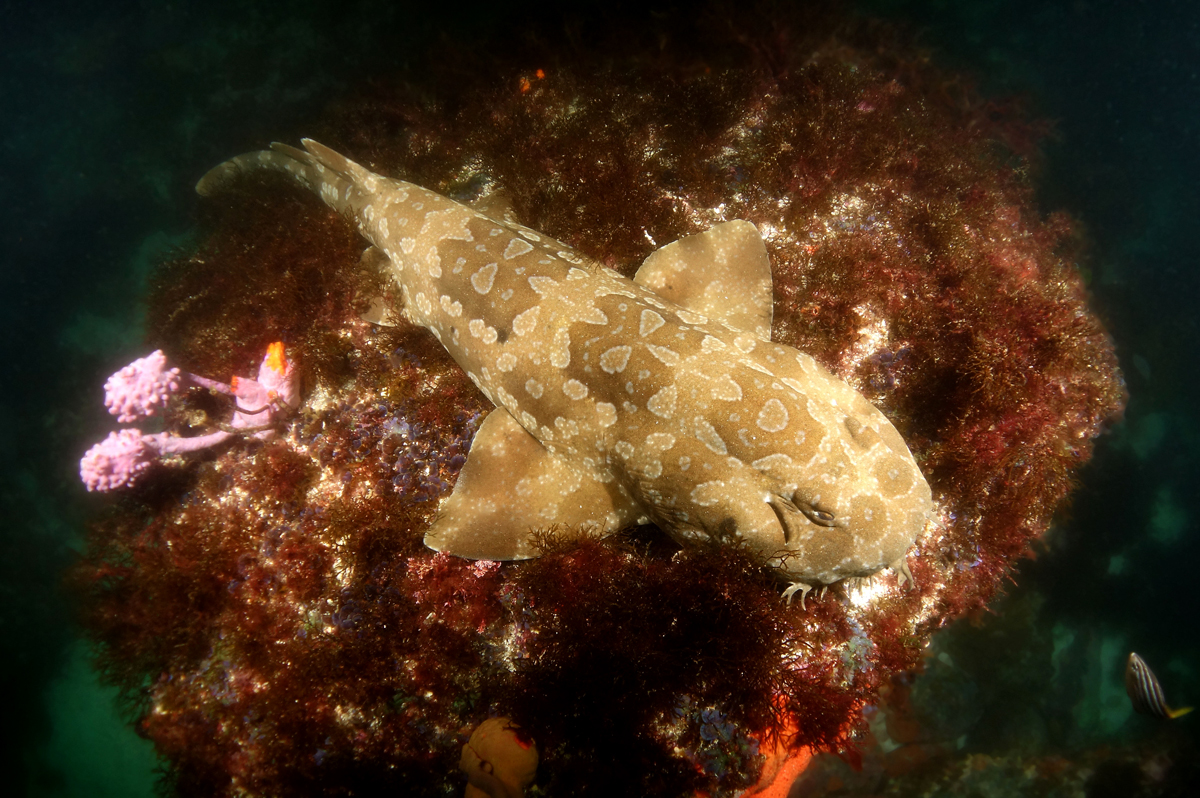Spotted Wobbegong, Orectolobus maculatus (Bonnaterre 1788)

A Spotted Wobbegong, Orectolobus maculatus, at Montague Island, New South Wales. Source: John Turnbull / Flickr. License: CC by Attribution-NonCommercial-ShareAlike
The Spotted Wobbegong is often confused with the Banded Carpetshark, Orectolobus halei, which has indistinct markings in the dark saddles and fewer fleshy lobes.
Great video of a Spotted Wobbegong at Bare Island, Sydney, New South Wales.
A Spotted Wobbegong in Cabbage Tree Bay, Manly, New South Wales.
Despite their seemingly docile nature, Spotted Wobbegongs have long, slender sharp teeth and may cause severe lacerations if provoked. Not only that, they seem reluctant to release their victims.
Spotted Wobbegong, Orectolobus maculatus (Bonnaterre 1788)
More Info
|
Distribution |
North of Swains Reef, Queensland, south to about Lakes Entrance, Victoria, and from about Warrnambool, Victoria, to North West Cape, Western Australia (Tasmanian and Northern Territory records probably in error). Although this species has been recorded from Japan and South China seas, it is most likely endemic to Australia. Inhabits reefs, sandy and seagrass areas in coastal bays. The species is nocturnal and individuals usually rest during the day. |
|
Features |
Body large, robust, no dermal ridges or warty tubercles along back; lateral head margin with 6-10 long, coarsely branched dermal lobes along each side before the eye - lobes absent from chin; small tubercle present above rear of eye. |
|
Feeding |
A nocturnal predator, feeding mostly on fishes and octopus, along with crabs and other crustaceans such as crayfish. |
|
Biology |
Individuals mature at 115-120 cm TL. Reproductive mode: aplacental viviparous (ovoviviparous) with females giving birth to up to 37 pups in spring following a 10-11 month gestation period. |
|
Fisheries |
Targeted and taken as bycatch in commercial and recreational fisheries. |
|
Conservation |
NSW: Listed as Vulnerable IUCN Red List: Near Threatened |
|
Remarks |
Although considered docile, bites from wobbegong sharks can not only cause severe lacerations, but the shark is often reluctant to release its victim. The International Shark Attack File records 23 confirmed attacks on humans by Spotted Wobbegong sharks. |
|
Similar Species |
The Spotted Wobbegong differs from Orectolobus halei in having saddles with whitish rings and blotches, and more dermal lobes (6-10) at the rear end of the preorbital group. |
|
Etymology |
The specific name maculatus is from the Latin maculosus meaning 'spotted', in reference to the spotted pattern on the body. |
|
Species Citation |
Squalus maculatus Bonnaterre 1788, Tableau encyclopédique et méthodique des trois règnes de la nature... Ichthyologie: 8. Type locality: southwestern Pacific (as La mer du Sud) - presumably Australia. |
|
Author |
Bray, D.J. 2023 |
|
Resources |
Spotted Wobbegong, Orectolobus maculatus (Bonnaterre 1788)
References
Bloch, M.E. & Schneider, J.G. 1801. Systema Ichthyologiae Iconibus ex Illustratum. Berlin 584 pp. 110 pls. (as Squalus lobatus)
Bonnaterre, J.P. 1788. Tableau Encyclopédique et Méthodique des trois Règnes de la Nature. Ichthyologie. Paris. pp. 1-215, 102 pls
Chidlow, J. 2003. Biology of wobbegong sharks from Western Australia. Unpublished M.Sc. Thesis.
Coleman, N. 1980. Australian Sea Fishes South of 30ºS. Lane Cove, NSW : Doubleday Australia Pty Ltd 309 pp.
Compagno, L.J.V. 1984. FAO Species Catalogue. Sharks of the World. An annotated and illustrated catalogue of shark species known to date. Hexanchiformes to Lamniformes. FAO Fisheries Synopsis No. 125. Rome : FAO Vol. 4(1) pp. 1-249.
Compagno, L.J.V. 2001. Sharks of the World. An annotated and illustrated catalogue of shark species known to date. Bullhead, mackerel and carpet sharks (Heterodontiformes, Lamniformes and Orectolobiformes). Rome : FAO, FAO Species Catalogue for Fisheries Purposes No. 1 Vol. 2 269 pp.
Compagno, L.J.V. & Niem, V.H. 1998. Families Squatinidae, Heterodontidae, Parascylliidae, Brachaeluridae, Orectolobidae, Hemiscylliidae. pp. 1235-1259 in Carpenter, K.E. & Niem, V.H. (eds). The Living Marine Resources of the Western Central Pacific. FAO Species Identification Guide for Fisheries Purposes. Rome : FAO Vol. 2 687-1396 pp.
Compagno, L.J.V., Dando, M. & Fowler, S. 2005. A Field Guide to the Sharks of the World. London : Collins 368 pp.
Corrigan S, Huveneers C, Stow A, Beheregaray (2015) A multi-locus comparative study of dispersal in three codistributed demersal sharks from eastern Australia. Canadian Journal of Fisheries and Aquatic Sciences. doi: 10.1139/cjfas-2015-0085 PDF available, Open Access
Gmelin, J.F. 1789. Pisces. pp. 1126-1516 in Linnaeus, C. (ed.) Systema Naturae. Leiden : Delamollière Vol. 1 Pt 3. (as Squalus barbatus)
Grant, E.M. 2002. Guide to Fishes. Redcliffe : EM Grant Pty Ltd 880 pp.
Günther, A. 1870. Catalogue of the Fishes in the British Museum. Catalogue of the Physostomi, containing the families Gymnotidae, Symbranchidae, Muraenidae, Pegasidae, and of the Lophobranchii, Plectognathi, Dipnoi, [thru] Leptocardii, in the British Museum. London : British Museum Vol. 8 549 pp. (as Crossorhinus barbatus)
Hutchins, J.B. & Swainston, R. 1986. Sea Fishes of Southern Australia. Complete field guide for anglers and divers. Perth : Swainston Publishing 180 pp.
Huveneers, C. 2006. Redescription of two species of wobbegongs (Chondrichthyes: Orectolobidae) with elevation of Orectolobus halei Whitley 1940 to species level. Zootaxa 1284: 29-51. https://doi.org/10.11646/zootaxa.1284.1.2
Huveneers, C. 2007. The Ecology and Biology of Wobbegong Sharks (Genus Orectolobus) in Relation to the Commercial Fishery in New South Wales, Australia. PhD Thesis, Macquarie University.
Huveneers, C., Otway, N.M., Gibbs, S.E. & R.G. Harcourt. 2007. Quantitative diet assessment of wobbegong sharks (genus Orectolobus) in New South Wales, Australia. ICES Journal of Marine Science 64: 1272-1281. PDF available
Huveneers C., Otway N.M. & Harcourt R.G. 2007. Morphometric relationships and catch composition of wobbegong sharks (Chondrichthyes: Orectolobus) commercially fished in New South Wales, Australia. Proceedings of the Linnean Society of New South Wales 128: 243-249.
Huveneers, C., Pollard, D.A., Gordon, I., Flaherty, A.A. & Pogonoski, J. 2015. Orectolobus maculatus. The IUCN Red List of Threatened Species 2015: e.T41837A68638559. http://dx.doi.org/10.2305/IUCN.UK.2015-4.RLTS.T41837A68638559.en. Downloaded on 18 July 2018.
Waite, R.E. 1899. Scientific results of the trawling expedition of H.M.C.S. "Thetis", off the coast of New South Wales, in February and March, 1898. Introduction. Memoirs of the Australian Museum 4(1): 3-23 (as Orectolobus barbatus)








